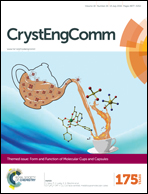Influence of the cavity dimension on encapsulation of halides within the capsular assembly and side-cleft recognition of a sulfate–water cluster assisted by polyammonium tripodal receptors†
Abstract
The p-nitrophenyl and p-bromophenyl functionalized tris-polyamine receptors, L1 and L2, have formed capsular assembly with halide ions in an encapsulated fashion through efficient hydrogen-bonding. On the other hand, the positional isomer of L1, the m-nitrophenyl functionalized tripodal amine receptor L3, displays a rather flat-open conformation and is unable to bind halide anions in an encapsulated form. The presence of a smaller cavity in these receptors hinders the binding of larger oxyanions like sulfate. As a result, the protonated tripodal scaffold encapsulates small solvent molecules and helps in side-cleft binding of the larger sulfate anion. Herein, we report the design, synthesis and characterization of tren-based polyammonium receptors L1, L2 and L3 and their complexation as well as binding discrepancy with several anions in the presence of acid. The solid state crystal structure of the anion complexes with L1, L2 and L3 reveal that the anions are recognized via stable N–H⋯A, C–H⋯A, anion–π interactions with the protonated receptor molecule in a unimolecular fashion either inside or outside the cavity. The sulfate–water complexes of receptors L1, L2 and L3 are stabilized by (NH)+⋯O type H-bonding and electrostatic interactions among sulfate, water and ammonium groups. The polyammonium based tripodal scaffold with positional variation of the functional group shows significant difference in anion binding fashion through either capsular or non-capsular complex formation.

- This article is part of the themed collection: Form and Function of Molecular Cups and Capsules

 Please wait while we load your content...
Please wait while we load your content...